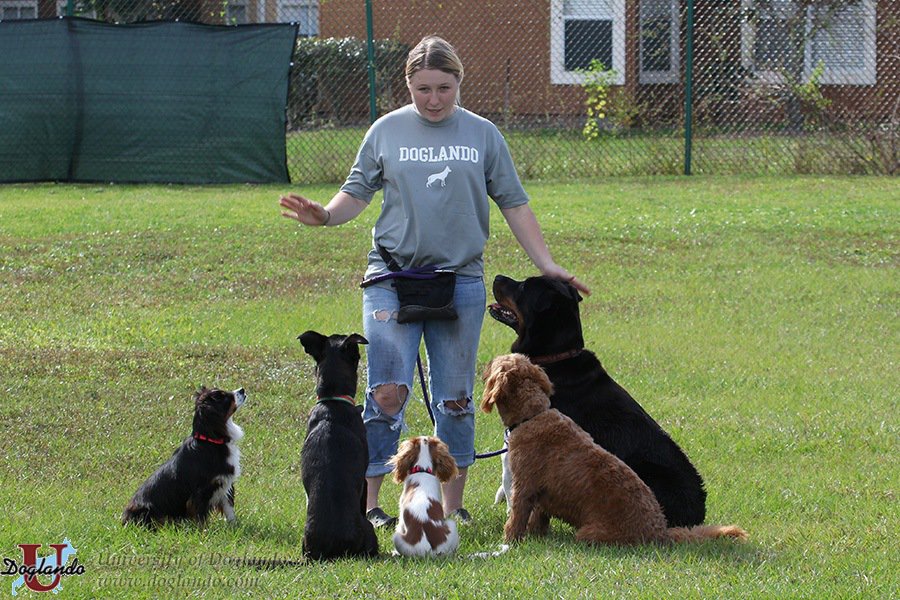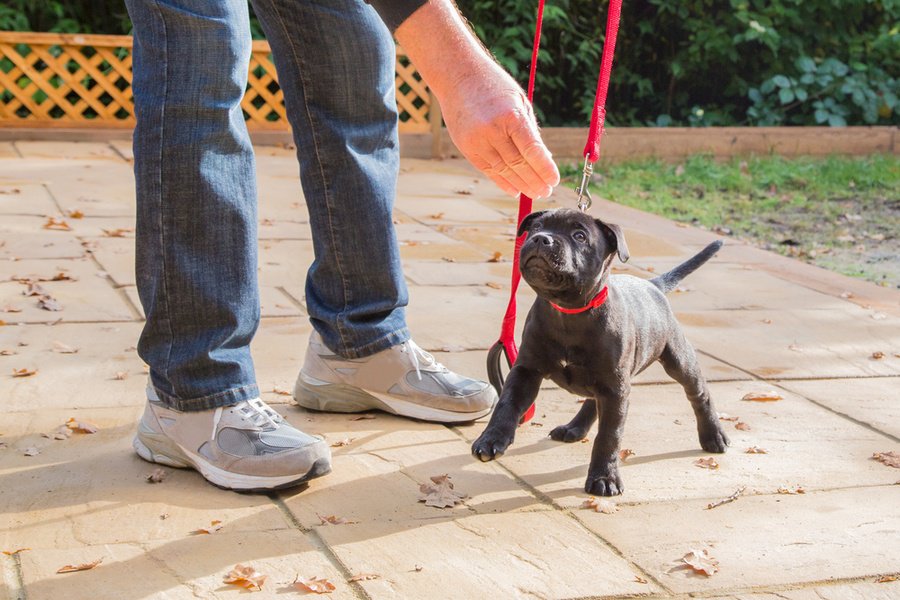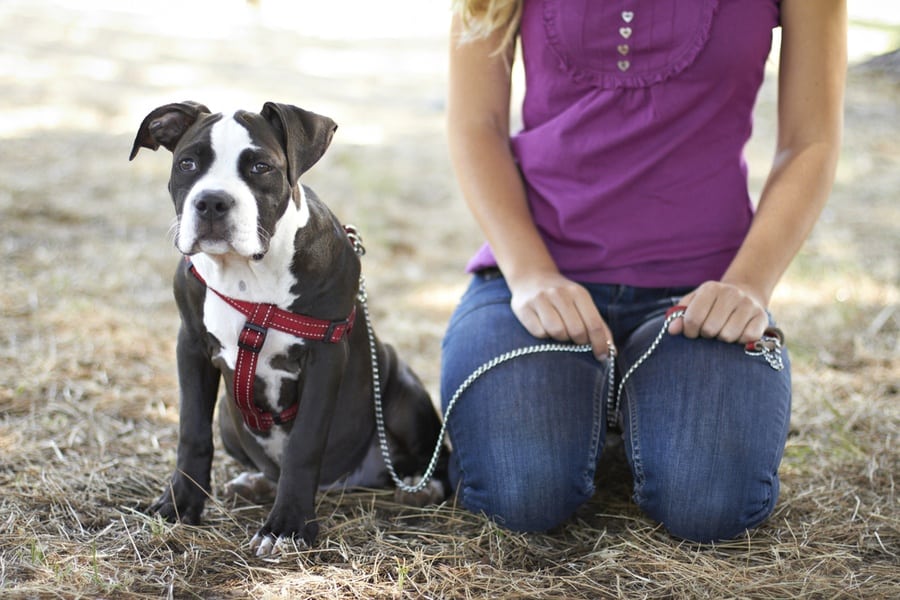“This post contains affiliate links, and I will be compensated if you make a purchase after clicking on my links.”

Why Train Puppies?
Go to any dog trainer’s website and you’ll find a discussion of why it is important to train puppies.
The most common claim made by trainers is that they will teach your dog to stop undesirable behaviors like jumping up on people, biting, and pooping in your house. Lots of different training methods are advertised, too:
Traditional dominance training, positive reinforcement, behavior modification, “dog friendly” training, and many others.
However, no matter what training method is being advertised, most dog trainers offer courses that are focused on obedience, and particularly the subordinate role of the dog to the owner.

Do I need to be the ‘leader of the pack’ with my dog?
One common catch phrase is that dogs, like wolves, are pack animals, and that the owner must become the dominant leader of the pack. This obedience training is designed to give the owner control over his dog’s actions, and concentrates on a limited number of “skills” that include coming, leaving an item, heeling, and staying in place.
The theory behind all obedience focused training is that by teaching the puppy these skills, the dog will be “safe”, both to itself and to others.
There are two crucial weaknesses in all obedience-based training, though:
- The false assumption that dogs and people comprise a pack. Dogs are not wolves. They have been bred to live within a human context on a basis of mutual respect and interaction rather than dominance and submission.
- The focus on perceived human needs rather than on the actual lived experience of the dogs.
The true purpose of meaningful and effective puppy training is to prepare each dog to meet the full range of obligations and challenges that it will face living with a human family in a human world.
On its own, obedience training is insufficient to achieve this goal because it does not relate to the entirety of the dog’s experience. Truly effective training requires seeing the world from the dog’s perspective and then utilizing the concept of behavioral wellness.

What is Behavioral Wellness?
We all have an understanding of the concept of wellness as it relates to our physical health. We know that if we do things like eat the right foods, exercise, and get enough sleep we maximize our opportunities to be healthy and feel well. In short, achieving physical wellness requires the development of a thorough plan of active care with a systematic and ongoing implementation of our program.
Believe it or not, this same relationship between input and result can be seen in behavior!
Understanding how environment influences behavior
In the broadest sense, behavior is anything that a dog, a human, or any other creature does in reaction to its environment. Behavioral wellness, therefore, is the positive end state of a well-designed and actively implemented plan that is intended to bring about a desired group of behaviors.
But, just as achieving physical wellness requires the implementation of a holistic approach to the individual’s range of needs, behavioral wellness as it relates to animals is far more than instilling simple obedience.
Behavioral wellness also enhances the human-animal bond and the animal’s quality of life by taking account of its entire range of experiences and challenges.

Where is Behavioral Wellness Implemented?
Behavioral wellness has been at the center of animal care and training at zoos and aquariums for many decades. The professionals caring for these animals have an obligation to create physical environments that will allow them to thrive, and they must also interact with them under a wide range of circumstances, from during feeding to veterinary treatments, and everything in between.
For example, zoo keepers routinely clean the teeth of large and potentially dangerous animals like lions, wolves, and hippos. Before the development of behavioral wellness as a defining characteristic of animal care, zoo keepers tranquilized animals to get at them, sometimes causing significant injury.
Nowadays, modern zoos break every aspect of a veterinary procedure down into its component parts. Animals are trained in these components from a very young age, from coming to a sitting position when summoned, to opening their mouths at a signal, to sitting still without reaction while being brushed.
This process of training anticipates all the challenges that the animal will face in its lived experience within its own environment, and then focuses on teaching them to perform the necessary tasks on a step by step basis. Consequently, the animal benefits by receiving a veterinary service, and does so without need for coercive action that would be potentially dangerous to both human and animal.

How Do We Bring Behavioral Wellness to Puppy Training?
First, behavioral wellness requires we train puppies to understand their own bodies before learning complex or even simple skills.
If they were left with their mothers and litter mates, puppies would gain body awareness through natural interactions. But, forcible weaning and separation by eight weeks old means that puppies don’t even know where their legs are, or that they have a head in front and tail in the back.
When we understand the world from the puppy’s perspective, it becomes clear that they need to learn about their bodies first. They’ll be ready to learn new skills and experience new sensations once they have complete body awareness.
Once the training of specific skills begins, it’s crucial that we continue to think about the world through the puppy’s eyes, and envision the whole range of experiences and challenges that he will face.
Take, for example, the signal for a dog to sit. If you take your puppy to a dog trainer, you’ll enter a room and there you will learn the techniques to have the dog sit in the middle of the floor.
The dog trainer may be excellent at teaching you and your dog how to achieve this goal. But what life lesson is your dog learning?
When will your dog need to sit in the middle of the floor during “normal” life? This is an entirely artificial environment that has no relationship to your dog’s lived experience, and will not prepare him to operate effectively in the real world.

When applying the principles of behavioral wellness, training is designed to prepare the dog to successfully undertake tasks that it needs to do throughout life, like sitting outside a doorway to the house while cars drive by, birds sing, and other dogs patrol nearby yards. Even more mundane factors such as door stops can throw your puppy into a spasm of play and distraction. Learning to sit in the middle of the floor in a room with minimal stimuli will not prepare your dog for any of these challenges.
You cannot take a puppy and simply compel him to sit outside the front door of a house on a busy street or to ignore the tempting springiness of a door jamb.
Just like the hippo in the zoo, training your puppy requires understanding the real behavior that you wish him to demonstrate, breaking down this behavior into its component parts, and then teaching your dog how to perform each of these individual steps building up to the ultimate goal.
In the case of our sitting dog, training should begin by teaching him to sit for a short period next to a door. Once he has achieved this goal, increase the duration of time that he sits. After he has mastered this stage, gradually increase both the duration of the exercise and the stimuli in the environment. Ultimately, consistent but gradual increases in the challenge will lead to the desired result, which is a dog that can sit calmly for lengthy periods even when faced with a highly stimulating environment.

What Can I Do to Help My Puppy Succeed?
Your puppy is always learning: from you, from other dogs, and from his physical environment.
In order to give your puppy the best chance to live an enriching and fulfilling life, it is crucial to see the world through his eyes and to direct this learning so that he can succeed in meeting the real challenges that he faces.
With that in mind, an important first step is to find a dog trainer who understands how to make behavioral wellness the focal point of your puppy’s training. Here are two resources you can browse to find the best trainer, and to learn more on your own:
Association of Professional Dog Trainers Trainer Search
BehaviorWorks, from Dr. Susan Friedman
Teena Patel, LLA CPDT, has a bachelor of science degree in comparative psychology and an MBA.
Teena is founder of the Country Day School at the University of Doglando, a 4 acre educational and enrichment center in Orlando. Teena is inspired by the idea that responsible pet-ownership requires a focus on the whole dog and teaching life skills rather than amusing tricks. She has developed new training methods to teach people how to interact positively with their animals starting most critically when they are puppies, and to integrate them fully into their lives. She brought this new model to Doglando, where a staff of professional trainers engage with their canine students of all ages throughout the school day to encourage positive behavioral outcomes. Patel has earned a national reputation for her innovative approach to training and dog care, and routinely consults around the country on her philosophy of enrichment, education, and improving dogs’ behavioral health.























